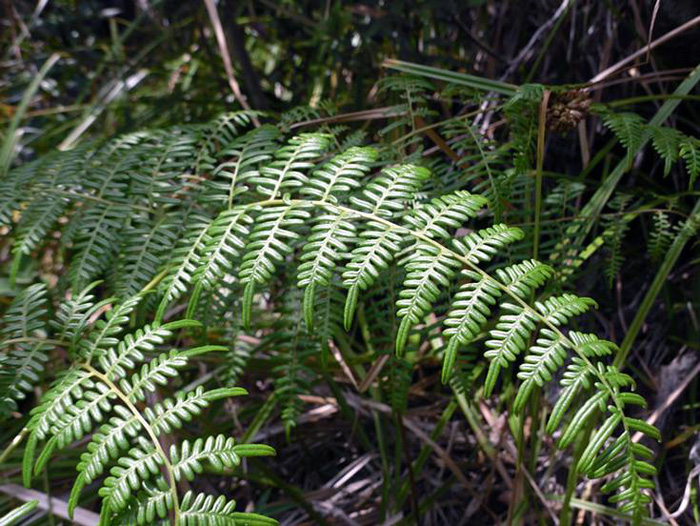In the middle of her job consolidating the herbarium in San Andres, Providencia and Santa Catalina, a particular finding called the attention of two researchers from Universidad Nacional de Colombia; a male fem whose natural habitat is far from the sea.
Its distribution had been previously reported in the valleys, savannas, mountain ranges and plains around the country; for this reason, its presence in Serrania El Pico, in the zone of Providencia, declared Regional Natural Park, resulted strange.
The question was: How did it get to such ecotouristic area, cataloged as the less intervened zone in the archipielago" The Biologist Alexandra Tobar and the taxonomist Brigitte Gavio (an expert in classifying species) from Universidad Nacional de Colombia in the Caribbean, have a hypothesis: the plant, which belongs to the Pteridium caudatum species, was brought in planters from the central region of the country, where it is used as decoration and as a purgative.
The researchers based the hypothesis on the observation they made of this fem in planters and yards used as decoration in houses next to the natural reserve. "This means that inhabitants took it to El Pico and planted it there. Due to the hot weather and the soil conditions on the island, from volcanic origin and moderately acid, it just bloomed."
However, the concerns of these experts go beyond. Such concerns are related to a toxin originated in this fem that can produce gastric damages in cattle and other animals that consume grass, since the toxic can accumulate in their meat and from there it can easily be consumed by humans.
According to Gavio, the dispersion of this fem could reach the lands of the Serrania and could contaminate the drinking water. "On the island, drinking water sources that supply the inhabitants are subterraneous and their alteration would generate a problem of public health."
Animal Health
This fem contains cancerous substances whose main molecule is called Ptaquiloside (pq). According to previous reports about this plant, found by the researchers, once cattle eat the plant, it releases substances and affects different organs of the digestive system.
Kidneys and the mucosa of the urinary bladder are the most affected, asserted Carlos Moreno, a medical veterinarian from Universidad Nacional de Colombia. "Initially, the pq molecule provokes cystitis to bovines, and with time, a chronic inflammation that results in bladder carcinoma. Symptoms start with a red urine (hematuria), producing the animal"s death.
Public health
This disease can generate gastric cancer in animals, "for this reason, milk can affect those who drink it," mentioned Tobar.
According to the biologist, investigations in Costa Rica and Japan show a high rate of deaths due to this cause, since a considerable percentage of milk comes from caws fed with these types of plants. Another factor of influence is the consumption of this fem in salads, as it occurs in Japan, and the use of its leaves to wrap food.
To this respect, William Otero, a gastroenterologist from Universidad Nacional de Colombia, asserted that "Colombia does not have a scientific document that supports the probability of having a part of the population suffering from diseases due to the intake of the fem or milk," therefore, it is necessary to study more in order to assert or discharge any possibility.
Prevention
The identification of this fem in Providentia constitutes a botanic contribution to the inventory of terrestrial flora in the archipielago, which is vulnerable to introduced species such as Pteridium caudatum, whose reproduction with spores, and not with seeds, makes its eradication difficult.
In the past, the burning of terrain was used to eradicate dangerous vegetation for the population. The researchers recommend to the inhabitants of the island to avoid this practice, since the fem is resistant to fire due to the physical characteristics of its rhizome (root) and the chemical characteristics of the spores.
"While other species die due to the high temperatures, this fem resists. Although its leaves burn, the rhizome survives, generating new outbreaks that spread due to the absence of vegetal competitors," asserted Tobar.
A study suggests the environmental authorities to monitor this toxic plant that reproduces at highs of 130 meters over the sea level, and whose presence has been detected in seven parts on the mountain"s peak so far.
Botanical records indicated that in the national territory there are close to 1,600 species of fem, distributed in 36 families and 130 genera.
 Correo Electrónico
Correo Electrónico
 DNINFOA - SIA
DNINFOA - SIA
 Bibliotecas
Bibliotecas
 Convocatorias
Convocatorias
 Identidad UNAL
Identidad UNAL



